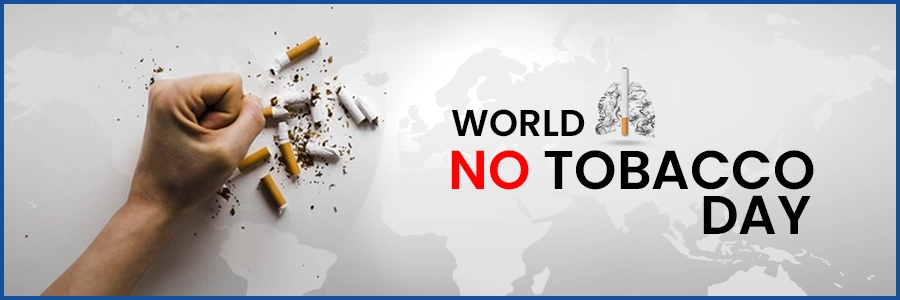World No Tobacco Day, 2023

World no tobacco day is marked on 31st May every year. This initiative was taken by the World Health Organization (WHO) in 1987 to draw everyone's attention to the tobacco epidemic. In addition, the day allows us to spread awareness to the general public about the harmful effects of tobacco.
This annual campaign has a different theme each year. This year's theme for World No Tobacco Day 2023 is "We need food, not tobacco", which aims to raise awareness of alternative crop production and marketing opportunities for tobacco farmers and encourage them to grow sustainable and nutritious crops.
What is tobacco?
Tobacco is a plant cultivated for its leaves, which are dried and fermented to make tobacco products. It contains nicotine, an ingredient that can lead to addiction, which is why so many smokers struggle to quit.
Tobacco is commonly used for smoking (Cigarette smoking, cigars, pipe tobacco, roll-your-own tobacco, hookah tobacco or waterpipe tobacco, bidis, kreteks and cigarillos. However, it can be used in various ways, such as chewing, applying, sucking, sniffing, gargling, etc.
It is reported that around 14% of adults smoke tobacco, whereas about 26% use smokeless tobacco, including tobacco in other forms. The presence of nicotine in tobacco is responsible for getting addicted to cigarettes and other forms of tobacco. The nicotine content in cigarettes can range from 5.7 mg to 13 mg, whereas a packet of gutkha or khaini contains approximately 1.7 to 76 mg of nicotine based on the product.
Be it smoking or chewing; tobacco contains nicotine and many other carcinogenic compounds that increase the risk of different forms of cancer like oral cancer,throat cancer,lung cancer, etc. In addition, regular consumption of the harmful product can also cause tooth decay,gum disease, staining of teeth, loss of a tooth, and other cardiovascular diseases.
What is smokeless tobacco?
There are mainly two types of smokeless tobacco: chewing tobacco and snus.
Chewing tobacco usually comes in the form of leaves or plugs that are placed on the inside of your cheek and chewed. Chewing the tobacco releases the flavors and nicotine, causing your mouth to produce a large amount of saliva. This is usually spit out by users. Snus is tobacco that comes in the form of a moist powder or small bags that you place under the inside of your bottom lip.
Both types of smokeless tobacco are addictive and can cause serious health problems. Smokeless tobacco users are especially vulnerable to throat cancer and oral cancer because they frequently swallow tobacco juice. Because tobacco is pressed against the mouth lining, cancers of the lip and cheek are also common. If you are using smokeless tobacco, you should see the dentist on a regular basis. This is due to the fact that your check-up will include a full mouth examination during which the dental team will look for any of the signs of oral cancer.
Can smokeless tobacco be part of other chewing products?
Yes, smokeless tobacco goes by different names such as paan masala (Gutkha), snuff, zarda, nass, snus, supari, khaini, ariva, mawa, mishri, toombak, qiwam or kima, chimo. People who use it don't always know or use the term 'smokeless tobacco', so they often don't realize that the products contain tobacco. If you aren't sure, look on the packaging for names or ingredients like those we've mentioned above.
Effects of tobacco products on health:
Tobacco in the form of smokeless and smoke impacts the health of a person in many ways, affecting almost every body organ and causing a lot of illnesses.
- Increased risk of gum infections and tooth loss.
- Wounds taking longer to heal
- Decreased immune system function
- Increased risk of type 2 diabetes
- Decreased sense of smell and taste
- Premature aging of the skin.
- Bad breath and stained teeth
- Increased risk for cataract
- Lower bone density which means a higher risk for broken bones, including hip fractures.
- Higher risk of developing rheumatoid arthritis.
- Increased risk of age-related macular degeneration, which can cause blindness.
- Increased risk of peptic ulcers.
Treatment
Nicotine replacement therapy:
Nicotine replacement therapy is primarily used to treat nicotine addiction. It is available as gum, sprays, a patch, lozenges, and inhalers. Nicotine replacement products supply enough nicotine to prevent withdrawal symptoms and therefore prevent relapse. Prescription medicines such as bupropion and varenicline tartrate have been effective for those who are trying to quit nicotine.
Behavioural treatment:
Behavioural treatment includes psychological support and skills training to overcome high-risk situations.
Benefits of quitting the use of tobacco:
Quitting the use of tobacco is one of the best things individuals can do to improve their health and reduce the harmful effects of tobacco. The benefits of quitting tobacco are:
- Reduced risk of cancer: Tobacco use is a major risk factor for different types of cancer, such as lung, throat, mouth, bladder, kidney, and pancreatic cancer. Quitting tobacco can reduce the risk of developing these types of cancer.
- Improved lung function: Tobacco use can damage the lungs and lead to chronic obstructive pulmonary disease (COPD) and other respiratory conditions. Quitting tobacco can improve lung function and reduce the risk of respiratory illnesses.
- Better cardiovascular health: Tobacco use is a major risk factor for stroke, heart disease, and other cardiovascular conditions. Quitting tobacco can improve heart health and reduce the risk of developing these conditions.
- Reduced risk of premature mortality: Tobacco use is associated with a significantly higher risk of premature mortality. Quitting tobacco can reduce the risk of premature death and improve overall life expectancy.
- Improved quality of life: Tobacco use can have a negative influence on physical and mental health, as well as social and economic well-being. Quitting tobacco can improve quality of life and lead to a healthier, more fulfilling life.
Let us have a tobacco free environment so that future generations can live happily!